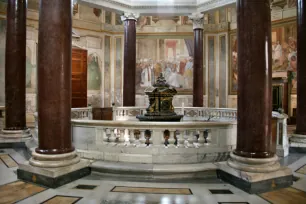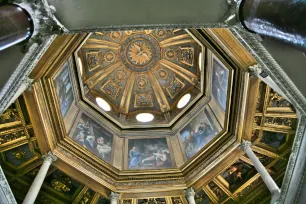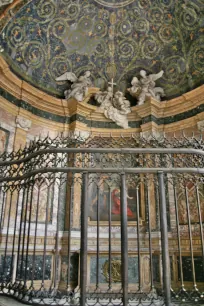The Lateran Baptistery is the oldest baptistery in the world. Its interior was completely renovated in the seventeenth century, but in the chapels you can still admire beautiful mosaics from the fifth to the seventh century.
Early History



The baptistery, which is also known by the name of San Giovanni in Fonte, dates from the time of Emperor Constantine and was located in the Domus Faustae, the residence of the emperor’s second wife. In those days, this was the only baptistery in the world and all Christians were baptized here by the pope. As the religion spread, this became impractical and priests were allowed to baptize as well.
According to legend, Constantine himself was baptized here in 324 by Pope Sylvester I. In reality, Constantine was baptized in 337 on his deathbed in Achiron, near Nicomedia.
The Current Baptistery
The original baptistery, which was merely a room with a nymphaeum (a fountain with a natural spring) in the baths of the Domus Faustae, was soon replaced by a circular building. The current, octagonal building dates from 432 and was built by Pope Sixtus III.



The actual entrance and narthex of the baptistery is on the south side, but you can now enter the building from the north side at the Piazza Giovanni Paolo II (formerly Piazza San Giovanni in Laterano), near the side entrance of the Lateran Basilica.
Architecture
The octagonal-shaped baptistery has served as a model for baptisteries worldwide. The brick exterior looks rather austere and from the piazza the only visible decorative elements are the reliefs with the insignia of Pope Alexander VII on the frieze below the roof, created in 1657 by Francesco Borromini. The narthex on the other side is beautifully decorated with an ancient carved entablature and porphyry columns in Corinthian order.
The building was renovated several times during its lifetime. The dome, which originally rested on an architrave, is now supported by an arcade that rests on classical porphyry columns. The Baroque interior decoration is relatively recent and dates from the seventeenth century. That includes the ornate bronze cover on the font, but the font itself – a basalt bathtub – is from antiquity.
Chapels
Several chapels adjoin the baptistery. On the west side is the chapel of John the Baptist, built during the pontificate of Hilarius (461-468). Its bronze doors were taken from the Baths of Caracalla. When the heavy doors are opened, vibration causes the hinges to create a musical sound resembling an organ pipe.
Opposite is the chapel of John the Evangelist, built in the fifth century. Its bronze door, created in 1196, was modeled after that of the chapel of John the Baptist.
The small apse-shaped chapel of Secunda and Rufina is decorated with a mosaic from the fifth century that shows acanthus leaves against a blue background. They contrast starkly with the Byzantine-style mosaics of the chapel of San Venanzio, built in 640 by Pope John IV. San Venanzio (Saint Venantius Fortunatus) was a bishop and poet from the sixth century. Despite his name suggesting otherwise, he was never canonized.

